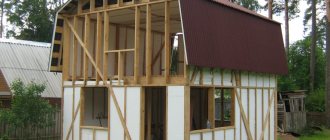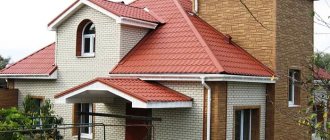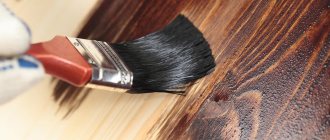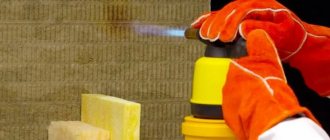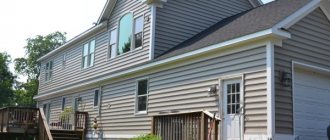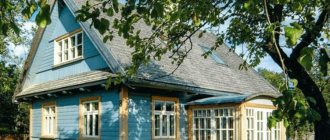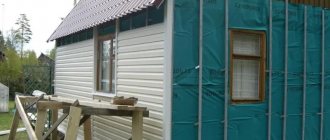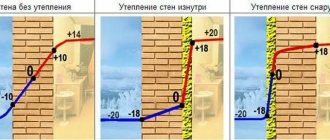Insulating a wooden house with polystyrene foam Foam plastic is a fairly popular thermal material today. It is quite often used to insulate various buildings. And this is easy to explain. It is highly efficient and practical, and is also accessible to every person. But still, before insulating a wooden building, purchasing a heat insulator and starting installation work, it is worth studying the product well and understanding whether it is possible to insulate a wooden house with polystyrene foam. Find out all the pros and cons of the material.
Polystyrene foam is a class of building materials that consists of foamed (cellular) plastic masses. Since the main volume of polystyrene foam is gas, its density is significantly lower than the density of the original raw material (polymer). One of the most famous and widely used types of foam today is extruded polystyrene foam.
Thermal insulation of a wooden house with polystyrene foam - Pros and cons
Do-it-yourself high-quality thermal insulation of a wooden house with polystyrene foam has a number of advantages and disadvantages. That beige has both positive factors and serious negative aspects. Next, we will try to consider in detail all the pros and cons of this thermal product and determine whether or not it is worth insulating a wooden house with polystyrene foam.
Advantages - advantages of polystyrene foam
Any thermal insulation of a building involves eliminating serious heat losses from the building and creating a favorable microclimate in the room. Insulating a wooden house using polystyrene foam (expanded polystyrene) has the following positive aspects:
- Relatively low cost. In comparison with other thermal insulation materials, the thermal product in question is much cheaper. In addition, you can purchase it at almost any construction store.
- Good thermal insulation characteristics. This insulation is as effective as mineral wool or Penoplex. The average thermal conductivity coefficient of the mentioned building materials is almost similar.
- Quite easy to use. The product is easy to cut. You can install polystyrene foam yourself without using special protective equipment. The insulation, to the walls of the house, both outside and inside, is easily fixed with glue and special fungi.
- Small size and weight. Delivery of expanded polystyrene is one of the clear advantages of the product. Thermal material can be transported independently. Such a positive factor will significantly reduce costs for construction activities, especially when transporting heat insulation over long distances.
Polystyrene foam as insulation
The advantages of building materials, which make it worthwhile to insulate a house with polystyrene foam, do not end there. This heat insulator does not pose any danger to humans. It can be installed both inside and outside the building.
But still, it is worth remembering the shortcomings of the product, which greatly limit its widespread use. Next, we will analyze in detail all the disadvantages of the material.
Disadvantages of polystyrene foam
Before insulating a wooden house with polystyrene foam yourself, you need to immediately decide whether the pros outweigh the cons, of which this thermal material has quite a few. Among them there are a number of disadvantages that greatly hinder the use of heat insulators for some construction and capital structures. The main disadvantages of expanded polystyrene are the following factors:
- It is not recommended to insulate building structures where there are serious loads with polystyrene foam. The heat insulator has relatively low strength and is quickly destroyed under strong impacts. Therefore, it can be used where the product will be reliably protected from loads. For example, to insulate the ceiling from inside the room.
- Foam plastic quickly loses its original appearance and collapses when exposed to moisture and low temperatures. Therefore, thermal insulation of a basement or basement with this product is unacceptable.
- Expanded polystyrene belongs to the group of highly flammable building materials. Thermal insulation of a private house with polystyrene foam must be done in strict compliance with building codes and regulations, as well as fire safety.
- Polystyrene greatly impedes the passage of air. You can insulate a wooden house with polystyrene foam yourself. But still, you need to understand that a permanent structure made of wood loses almost all its advantages. The choice to build a house made of wood assumes not only external aesthetics, but also that the walls of the building will “breathe” well and create a comfortable, favorable microclimate. And polystyrene foam prevents the free movement of air.
Insulating a wooden house with polystyrene foam, without organizing reliable protection against mold and mildew, means a noticeable reduction in the service life of the structure.
To protect the material and increase the service life of the structure, you need to leave a small gap between the wall and the insulation for free air circulation. This approach will allow moisture to be removed from the structure on an ongoing basis. As a rule, this option is used when insulating the walls of a building with polystyrene foam from the inside. But creating an air gap outside is not so categorical.
Application area
Taking into account the previously described disadvantages, it is possible to accurately determine, without significant damage to the capital structure, the scope of application of polystyrene foam. If necessary, it is more expedient to carry out high-quality polystyrene insulation of wooden buildings from the inside than from the outside.
So, in the most effective and practical way, you can protect the thermal material from rapid destruction, and the building from defrosting. In buildings made of brick or concrete, it is imperative to use a vapor-proof material. Thus, it is necessary to thermally insulate a wooden permanent structure only when absolutely necessary, when other thermal insulation methods are unavailable or impossible.
Block buildings and buildings made of brick and stone are recommended to be insulated only from the outside. But it is not advisable to insulate wooden houses on your own from the outside with polystyrene foam.
The advantages of this insulation
What are the main advantages of insulation with this particular material? Several points can be highlighted here.
The first is, as mentioned above, high thermal insulation. Polystyrene foam is made using gas, which allows it to maintain the optimal temperature in the house.
The second is environmental friendliness. The material does not contain toxic substances, but only if the manufacturer did not use heat treatment during production.
The next advantage is high moisture resistance. This material does not retain moisture or accumulate it, that is, when insulating, dampness or the possibility of mold appearing is completely eliminated.
The fourth advantage is ease. The lightness of foam plastic greatly simplifies the insulation process, since the material can be easily cut or sawn.
And the last thing I would like to note is accessibility. The cost of this material is not high, absolutely anyone can afford it.
Insulate a wooden house with polystyrene foam ‒ Insulation of floors
Using thermal insulation from the inside, the main application area is usually the ceiling and floor. Laying thermal products into these building structural elements is very advisable. But when carrying out installation work, the strength of the material must be taken into account.
- The first option is the most suitable for concrete floors. This method involves laying insulation under a cement-sand screed. To avoid deformation of the foam, make a reinforced screed about 50 mm thick. To strengthen the structure, special reinforcing mesh with a diameter of 3 to 6 mm is installed.
Foam plastic under reinforced screed - The second option is more acceptable for buildings with wooden floors. In the first option, the insulation is mounted between the beams, in the ceiling or floor. In the second case, it is necessary to make a wooden frame, between the lags of which polystyrene foam is laid. True, in this case, the ceiling pie increases noticeably, seriously eating up the useful height of the living space.
Fastening foam plastic between beams
In addition, you can attach foam plastic to the ceiling, either with or without a frame. The choice of the correct fixation, as a rule, depends on what building material the ceiling is built from and the technical capabilities of the building structure.
Insulating the ceiling with polystyrene foam and glue
When insulating the ceiling with your own hands, you must provide for the possibility of waterproofing and vapor barrier. The material itself is warm and not afraid of water, but moisture can easily accumulate in the voids between the polystyrene balls. Manufacturers of heat insulators, as a rule, remain silent about this negative property of the product. A ceiling insulated in this way must contain the following layers (listed from bottom to top):
- The building material with which the ceiling is sheathed;
- vapor barrier recommended for waterproofing insulation;
- heat insulator;
- floor design;
- waterproofing;
- floor, next floor.
Insulation of attic floors
If there is a great need, insulate the floor of the room with your own hands, vapor barrier is also laid from below, and proper waterproofing is placed on top. It is important to know and understand that the first addition is located only on the warm air side, and the second, on the cold air side.
Technological difference between internal and external wall decoration
Most often, interior wall finishing is done using wet technology, that is, using glue. To save space inside the house, you should not use an additional frame or anything else. The stages of work are as follows:
- Surface preparation and adhesive application.
- Installation of foam plastic boards and blowing out the joints between them.
- Applying the base layer of plaster.
- Applying the final layer of plaster.
Exterior finishing is also done using wet technology in most cases. There is almost no difference between them. External installation differs only in some details and the number of work processes. An insulating film is used here, since external factors act on the foam from the outside. Stages of work:
- Cleaning the base and priming it.
- Installation of the base profile.
- Layout of insulation placement and “fitting” on glue.
- Eliminate gaps with foam and fix them with dowels.
- Attaching the waterproofing film.
- Applying the first layer of plaster.
- Reapplying a layer of plaster.
- Final application of the third layer of plaster.
- Decorative finishing upon request.
Insulation of house walls with foam plastic
It is not uncommon for the walls of a house to be insulated with polystyrene foam from the inside. At the same time, the installation of steam and water protection is also required. When performing interior finishing, you need to leave a small gap between it and the heat product to eliminate settled steam.
External insulation scheme under plaster
Insulation with foam plastic from the inside
It is important to understand that polystyrene foam is not the best option for wall decoration.
This heat insulator has extremely low air permeability. Therefore, it often creates a greenhouse effect in the room. Because of this, you will have to seriously think about arranging additional, forced ventilation. This means that to ensure a favorable microclimate, significant additional financial investments will be required.
Video description
Another option for protecting wood from moisture in the video:
Note! If you look at the websites of leading manufacturers of ready-made systems for plaster and curtain facades (Knauf, Ceresit, Scanroc), none of them have a vapor-tight membrane in their “pie” structure to protect the insulation.
Factory-made façade systems do not provide a vapor-tight membrane between the wall and the insulation. Source derevyannyydom.com
And the same requirements for drying the structure impose restrictions on the choice of insulation.
See also: Catalog of companies that specialize in insulating country houses.
Is it worth insulating a wooden house with polystyrene foam - Conclusion
Based on the above, we can draw a certain conclusion and accurately answer the question: “Is it worth insulating a wooden house with polystyrene foam?” Although polystyrene foam is a relatively inexpensive building material, it still has a number of significant disadvantages that greatly limit its use. It is wiser to use this heat insulator for floors than for walls of a room. For thermal protection of wooden buildings, if possible, it is better to use vapor-permeable materials. For example, mineral wool.
Preparatory work
Preparatory work is an important part of the building insulation process. It is especially important to carry them out correctly for a wooden house. Wood is the best building material, but without proper care it quickly turns to dust. To prepare your home for insulation you will need:
- brush;
- antiseptic;
- primer.
If the house has been in use for some time, then you will need to carefully inspect the surface of the walls from the outside before insulating it. In some places the wood may already be damaged. Problem areas need to be treated. This usually requires removing the top layer with a suitable tool. If there is paintwork that was applied not too long ago, then you can leave it. But it is important to be careful that the coating does not react with the foam, as its gradual destruction may occur. The best option would be to completely clean the outer surface of the wall using sanding machines and further process it and insulate it.
Wood must be coated with substances that increase its resistance to fire. They are called fire retardants. After this, treatment is carried out with an antiseptic composition. This is done so that pests that can destroy the walls from the inside do not grow inside the structure. If there are metal elements on the wall, then it is advisable to cover them with bitumen mastic, it will prevent the occurrence of corrosion. Next, the surface of the walls of the wooden house is covered with a primer. In addition to the antiseptic, it will strengthen the top layer and improve adhesion with the adhesive.
For a house made of solid timber, it is necessary to make an additional check of how the elements fit together one to one. If there are gaps between the beams, then it is better to caulk using hemp, moss or tow. This is a labor-intensive process, but it will improve the insulation of the entire house.
Features of finishing a dollhouse
Interior decor depends entirely on individual preferences. When choosing materials and finishing methods, the advice and ideas of experienced craftsmen will not be superfluous.
Recommendations:
- The paint must match the surface being painted: gouache is chosen for cardboard, and safe acrylic compounds are used for wood.
- For fragile houses, the decor is light and does not overload the structure.
- The presence of a drawer in the podium or a blind attic with a lid in wooden houses will allow you to store additional interior items or doll outfits in one place.
- Scrapbooking paper is universal in decorating a dollhouse: it is thick, does not fade, and has a huge variety of designs and textures. A small pattern will look more believable as wallpaper; a “wooden” print will add realism to the facade or floor.
- Handmade toy furniture will highlight the uniqueness of the dollhouse. You can make a beautiful chair from a plastic glass. The fireplace is easily assembled from matchboxes. From two cardboard blanks and a mat you will get a bench.
- Textiles will add comfort and texture to the interior. It is more convenient to attach curtains in a house from a box using hot glue. Velvet or velor will imitate carpeting.
- Instead of stairs, you can make an elevator car that the child can raise and lower using a chain.

